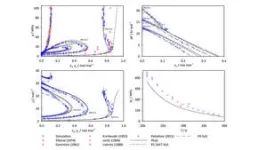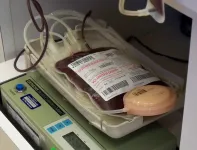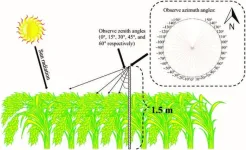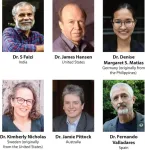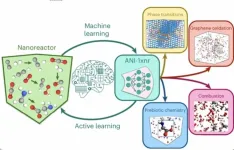Enhancing plant photochemistry analysis: a novel approach to chlorophyll a fluorescence measurement under environmental stress
2024-03-13
(Press-News.org)
Chlorophyll a fluorescence (ChlF) has been a pivotal tool in understanding plant photochemistry, offering insights into the energy transfer processes within chloroplasts and the efficiency of Photosystem II (PSII). Researchers have relied on quantifying ChlF through specific measures such as F0, Fm, and Fv under various lighting conditions to assess photosynthetic activities. Nonetheless, the technique encounters obstacles owing to the intrinsic uncertainties in gauging the absolute magnitude of ChlF and the fluctuation in baseline levels affected by environmental conditions. This complicates the interpretation of ChlF data and its correlation with photosynthetic efficiency.
In February 2024, Plant Phenomics published a research article entitled by “Dynamic Analysis of Chlorophyll a Fluorescence in Response to Time-Variant Excitations during Strong Actinic Illumination and Application in Probing Plant Water Loss”.
In this study, researchers employed a dynamic approach to measuring Chlorophyll a fluorescence (ChlF) in plants by using a pseudo-random binary sequence (PRBS) as a time-variant multiple-frequency illumination excitation under strong actinic light. This method allowed for the observation of ChlF responses not only in the time domain but also, and more importantly, in the frequency domain, emphasizing amplitude gain variations at different frequencies. By analyzing these responses amidst conditions of varying moisture levels, the study revealed significant insights into how nonphotochemical quenching (NPQ) and moisture loss impact ChlF dynamics. The results revealed that NPQ activities introduce nonlinearity and nonstationarity in ChlF responses, particularly affecting low-frequency responses below 0.03 rad/s, which exhibit a linear correlation with NPQ levels. This correlation suggests that low-frequency gain could serve as a compensatory measure for the variabilities encountered in ChlF measurements. Furthermore, the study demonstrated that while the low-frequency amplitude gain provides a direct link to NPQ, the high-frequency gain more closely correlates with plant moisture loss, suggesting that ChlF kinetics are markedly influenced by both NPQ and moisture status in a nonlinear manner.
In summary, this research not only underscores the complexity of ChlF responses under varying environmental conditions but also presents a novel methodological framework that leverages dynamic characteristics of ChlF to enhance the accuracy and utility of ChlF measurements in plant physiological research. The findings advocate for the use of frequency domain analysis to better account for variations in ChlF measurements induced by strong actinic illumination, offering a path toward mitigating these variabilities and improving the reliability of ChlF as a tool for assessing plant health and stress responses.
###
References
Authors
Junqing Chen1, Ya Guo2, and Jinglu Tan1*
Affiliations
1Department of Chemical and Biomedical Engineering, University of Missouri, Columbia, MO, USA.
2School of IOT, Jiangnan University, Wuxi, Jiangsu, China.
About Jinglu Tan
Jinglu Tan a professor in the Department of Chemical and Biomedical Engineering at University of Missouri. He serves as Director for the Division of Food, Nutrition & Exercise Sciences, a joint division between the College of Agriculture, Food & Natural Resources and the School of Medicine. His current research includes modeling and sensing of photoelectron transduction in plants and energy metabolism in muscles.
END
ELSE PRESS RELEASES FROM THIS DATE:
2024-03-13
Allergic transfusion reactions (ATRs), a potentially life-threatening side effect of blood transfusions with unclear mechanisms, may be linked to food allergies in pediatric patients as per a recent study by scientists from Japan. They found that ATRs may be triggered by the presence of allergens in the donor’s blood, influenced by their pre-donation diet. These findings could pave the way for safer blood transfusions through the development of preventive measures and countermeasures for ATRs.
Blood transfusions are often life-saving procedures in various medical settings. They are required not only after severe blood loss ...
2024-03-13
Melissa A. Kelly, MS, CGC is the recipient of the 2024 ACMG Foundation Carolyn Mills Lovell Genetic Counselor Award. Ms. Kelly received the Lovell award for her platform presentation at the 2024 ACMG Annual Clinical Genetics Meeting, “Integrating genomic medicine into healthcare: Experience disclosing >5,000 clinically relevant results within the Geisinger MyCode Community Health Initiative.”
Ms. Kelly said, “Thank you to the ACMG Foundation. I am humbled and honored to receive the Carolyn Mills Lovell Genetic Counselor Award. Throughout my career, I have seen many ways in which patients and their families interact with and are impacted ...
2024-03-13
Rory James Tinker, MD is the recipient of the 2024 Richard King Trainee Award. This award was instituted by the ACMG Foundation for Genetic and Genomic Medicine to encourage American Board of Medical Genetics and Genomics (ABMGG), international equivalents, or genetic counseling trainees in their careers and to foster the publication of the highest quality research in Genetics in Medicine (GIM), an official journal of the ACMG.
Each year the editorial board reviews all articles published in GIM by ...
2024-03-13
Meena Sethuraman, BS is the 2024 recipient of the ACMG Foundation/Revvity Travel Award. Ms. Sethuraman was selected to receive the award for her platform presentation, "Characterizing pathogenicity of ACADVL variants in very long-chain acyl-CoA dehydrogenase deficiency.”
Meena Sethuraman is a third-year medical student in the Physician Scientist Training Program at the University of Pittsburgh School of Medicine. Her research, being conducted with Dr. Jerry Vockley, FACMG, involves studying genetic variants in fatty acid oxidation disorders. Meena previously received her BS in Neurobiology at the University of Washington. Her undergraduate and post-baccalaureate ...
2024-03-13
Each year, the ACMG Foundation for Genetic and Genomic Medicine grants its Next Generation fellowship awards to promising early career professionals in a range of medical genetics and genomics specialties including Clinical Biochemical Genetics Laboratory, Laboratory Genetics and Genomics, Medical Biochemical and Ophthalmic Genetics. Support for this year’s class of Fellows was generously provided by Pfizer, Sanofi, Spark Therapeutics, Bionano and Horizon Therapeutics. The ACMG Foundation depends on corporate ...
2024-03-13
Solar-induced chlorophyll fluorescence (SIF) and the photochemical reflectance index (PRI) have emerged as significant tools in assessing the photosynthetic and carbon sequestration capacities of terrestrial vegetation, particularly for estimating gross primary productivity (GPP). However, the relationship between SIF, PRI, and GPP encounters challenges due to large temporal and spatial variabilities as well as the influence of various observational factors such as canopy structure and physiological state. Despite the potential of multi-angle observations and the Bidirectional Reflectance Distribution Function (BRDF) model to mitigate these ...
2024-03-13
Corvallis, OR — The Alliance of World Scientists (AWS) is pleased to announce the six recipients of the 2024 Planet Earth Award: Dr. S Faizi, Dr. James Hansen, Dr. Denise Margaret S. Matias, Dr. Kimberly Nicholas, Dr. Jamie Pittock, and Dr. Fernando Valladares.
Planet Earth Award
The AWS Planet Earth Award acknowledges individuals who champion life on Earth. These individuals demonstrate exceptional creativity or contributions in their work in science-based advocacy with the public, ...
2024-03-13
Computers work in digits — 0s and 1s to be exact. Their calculations are digital; their processes are digital; even their memories are digital. All of which requires extraordinary power resources. As we look to the next evolution of computing and developing neuromorphic or “brain like” computing, those power requirements are unfeasible.
To advance neuromorphic computing, some researchers are looking at analog improvements. In other words, not just advancing software, but advancing hardware too. Research from the University of California San Diego and UC Riverside shows a promising new way to store and transmit information ...
2024-03-13
DALLAS (SMU) – What exactly happens at the tiny scale at which individual atoms exist and interact? SMU chemist Elfi Kraka and her colleagues have been working on developing a computational tool aimed at providing answers to that mystery.
Mathematical functions used to calculate the potential energy of a system of atoms are called interatomic potentials. Machine learning interatomic potentials (MLIP)s have become an efficient and less expensive alternative to traditional quantum chemical simulations, which even on today’s high-performance computing often become out of reach for larger ...
2024-03-13
Although women have breastfed since the beginning of time, there is very little scientific research on how exercise affects breast milk.
Online forums for pregnant women and new mothers are full of questions about this exact issue:
Can exercise cause breast milk to go sour? What happens to breast milk if you do high-intensity interval training? Will strenuous exercise affect your milk supply?
“There are so many myths about exercise and breast milk. We simply need more knowledge,” says researcher Trine Moholdt at the Norwegian University of Science and Technology (NTNU).
She heads several international research projects ...
LAST 30 PRESS RELEASES:
[Press-News.org] Enhancing plant photochemistry analysis: a novel approach to chlorophyll a fluorescence measurement under environmental stress


